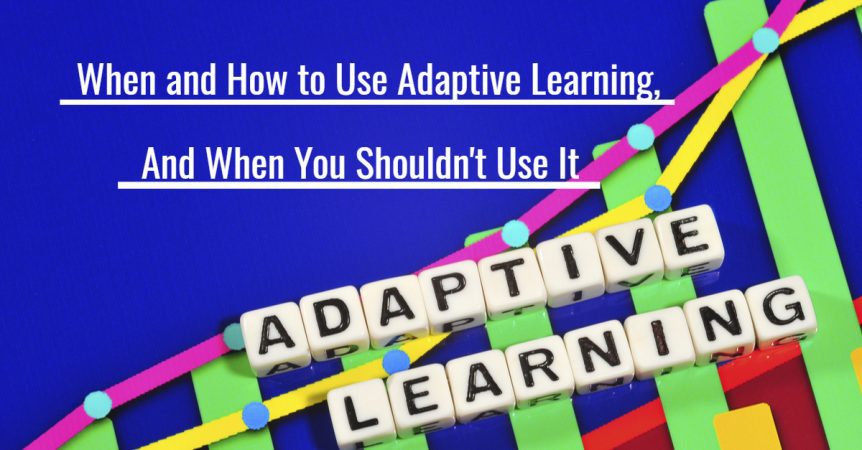When and How to Use Adaptive Learning, And When You Shouldn’t Use It
Experiences are an increasingly important focus area for businesses in all sectors. A lot of the discussions that take place about experiences focus on the customer experience, or CX. However, employee and learner experiences are important too. Optimising and improving the learner experience is the central principle of adaptive learning.
What is Adaptive Learning – A Quick Recap
In standard e-learning courses, the content is linear. You have a topic, and the learner starts at the start and finishes at the end, with all learners going through the same material.
With adaptive learning, you create personalised learning experiences. This ensures learners get the training they need without wasting their time or company time on training that either isn’t relevant to them or is on a subject they already know.
When and How to Use Adaptive Learning
There are lots of different e-learning and training strategies you can use in your business, but very few of them are suitable in every situation. This applies to adaptive learning too. It is right in some circumstances, but there are others where it wouldn’t make sense to use it.
Topics Presented to a Wide Group of People
Adaptive learning can be suitable if you are creating training on a topic that will be completed by a wide group of people, particularly if they have different needs, levels of knowledge, skill levels, and/or interests.
One of the main ways of applying an adaptive learning approach is through pretraining assessments. Learners do the pretraining assessment to decide which courses, modules, or elements they should complete. This can be done dynamically by the platform, or it can be a manual process where the pretraining assessment informs the learner who then uses that information to continue with their training.
Pretraining assessments often take the form of a quiz, but they don’t have to. In fact, for many training topics, e-learning scenarios can be more effective. A good example is leadership or management training. Rather than presenting the learner with blunt questions in a quiz format, you can assess the learner’s capabilities by creating a more realistic and relevant situation through a scenario.
It is also possible to use scenarios as both the pretraining assessment and the training at the same time. You can do this using a standard scenario format where you present the learner with a situation, and they are asked to make a decision or answer a question. If the learner gets the answer right, the scenario moves on. If the learner gets it wrong, further information is provided explaining why the answer or decision was wrong.
In other words, the scenario and responses of the learner are the pretraining assessment elements. The training then takes place when decisions or answers are incorrect.
Where Large Amounts of Training Need to Be Provided
Adaptive learning is also suitable in situations where you need to make available large amounts of information. An example is training on multiple products. Rather than creating a linear training experience where learners methodically go through the training for every product, you instead create a library of content that learners can complete as and when they need it.
This type of training approach is often called just-in-time training.
Where Training Accessibility is a Significant Factor
Adopting accessibility best practices is a good approach for all training content, but it is particularly important if you are aware that accessibility will be a significant factor.
While making e-learning courses accessible isn’t about delivering personalised content to learners, it does involve creating personalised experiences. Therefore, it can be regarded as a form of adaptive learning.
Where There Are Knowledge Gaps
Situations where you have knowledge gaps in the organisation can be suited to adaptive learning. An adaptive learning approach ensures learners only spend their time training in areas they need to improve.
That said, the best adaptive learning method for this situation can differ depending on what is known about the gaps in knowledge. There are two main categories:
- Where learners don’t know what they don’t know – pretraining assessments or scenarios are usually the best approach.
- People know what they don’t know – creating a library of courses is probably more beneficial in this situation.
Situations Where Adaptive Learning Is Not Suitable
As mentioned earlier, adaptive learning is not suitable in all situations. Some examples where a linear and uniform approach is more beneficial include:
- Training where everyone needs the same information, such as health and safety topics, compliance topics, etc.
- Urgent training topics as an adaptive learning approach will slow everything down.
- Topics where the information will not change, regardless of the learner. An example is training on the steps that need to be taken to complete a task.
Optimising the Learner Experience Through Personalisation
It is important to approach every training and e-learning development project with a focus on getting the best results and return on investment. Where adaptive learning can help you achieve those objectives, it is a method you should consider as it will not only help ensure successful training outcomes, but also improve the learner experience.
